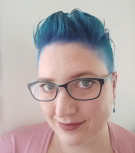This year’s CIEP conference was held online, from 12 to 14 September. Attendees from all over the world logged on to learn and socialise with their fellow editors and proofreaders, and a number of delegates kindly volunteered to write up the sessions for us. Katherine Kirk reviewed Fiction line-editing essentials: Narrative distance, presented by Louise Harnby.
 Near! Far!
Near! Far!
Louise Harnby is one of the most helpful editors around, and her Switching to Fiction course will earn you two points towards CIEP membership upgrades. This year, conference attendees got a taste of that high-quality content with Louise’s fabulous introduction to narrative distance. In her session, she explained:
- what narrative distance (or psychic distance) is
- why it should be dynamic, not static
- how problems with narrative distance connect to showing vs telling, info-dumping, head-hopping and other common pitfalls
- how editors can show writers how to adjust narrative distance to make their writing stronger.
Discussed in more depth in The Art of Fiction by John Gardner, narrative distance is a stylistic tool that affects point of view, showing versus telling, and more. It’s all about the relationship between reader and character: how deep in the character’s head is the reader, and how connected are they to the character’s emotions? To understand narrative distance, editors should know about narrative perspectives and their effects. Second-person is creepily intimate, third-person objective has the widest narrative distance, and third-person omniscient may have some intimacy between the reader and narrator, if not the characters. Editors who want to learn more about these would get a lot out of the CIEP’s Introduction to Fiction Editing course.
Louise describes narrative distance as a continuum that readers can zoom in and out of. The level of intimacy should gently ebb and flow. When it leaps around, that’s where problems come in. Overreliance on a wide degree of narrative distance makes the writing static and can result in info-dumping (and pace-killing). Spending too long in an intimate distance, putting emotion before description and action, can feel sentimental and overblown. Jumping too far from one degree to another can be jarring, like shifting gears too fast. Head-hopping is where the perspective leaps abruptly from one character to another, and readers get confused or can’t invest in the character’s experience. Some authors might overuse filter words (noticed, watched, felt) to avoid head-hopping, but this adds a degree of distance between the immediacy of the experience and the reader.
Louise says editors should not be too prescriptive regarding narrative distance. Instead, we should use our instincts and acknowledge subjectivity. A small change that shifts the narrative distance can have a huge effect on pace, emotional impact, and characterisation. We can use techniques like:
- free indirect speech
- removing filter words and words like ‘suddenly’ or ‘instantly’
- using characters’ full names
- changing direct speech and thought to reported speech or thought.
Being aware of narrative distance helps editors with the flow of prose, the shifts of intimacy with a single narrative style, and shifts of viewpoint. It helps authors to know how and why to fix problems, and it helps readers to enjoy the story more. Within a day of Louise’s talk, I’d already applied it to my own work. I can’t wait to see the lightbulbs pop on over my clients’ heads when I explain narrative distance to them.
 Katherine Kirk is a fiction editor who has lived all over the world, including China, South Korea, Ecuador, and Morocco, and she’s not done yet. She works on all types of fiction for adults, especially Science Fiction, Fantasy and Literary Fiction. She is a Professional Member of the CIEP.
Katherine Kirk is a fiction editor who has lived all over the world, including China, South Korea, Ecuador, and Morocco, and she’s not done yet. She works on all types of fiction for adults, especially Science Fiction, Fantasy and Literary Fiction. She is a Professional Member of the CIEP.
 About the CIEP
About the CIEP
The Chartered Institute of Editing and Proofreading (CIEP) is a non-profit body promoting excellence in English language editing. We set and demonstrate editorial standards, and we are a community, training hub and support network for editorial professionals – the people who work to make text accurate, clear and fit for purpose.
Find out more about:
Posted by Abi Saffrey, CIEP blog coordinator.
The views expressed here do not necessarily reflect those of the CIEP.
